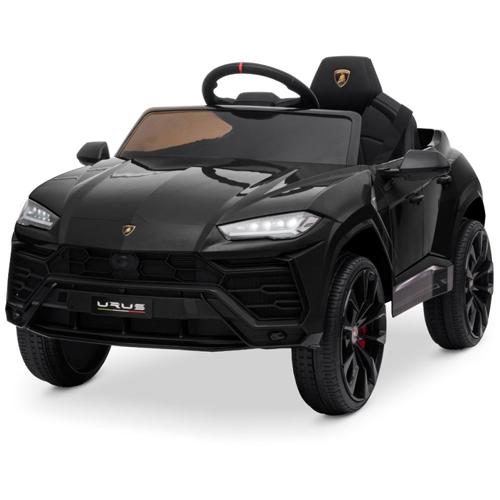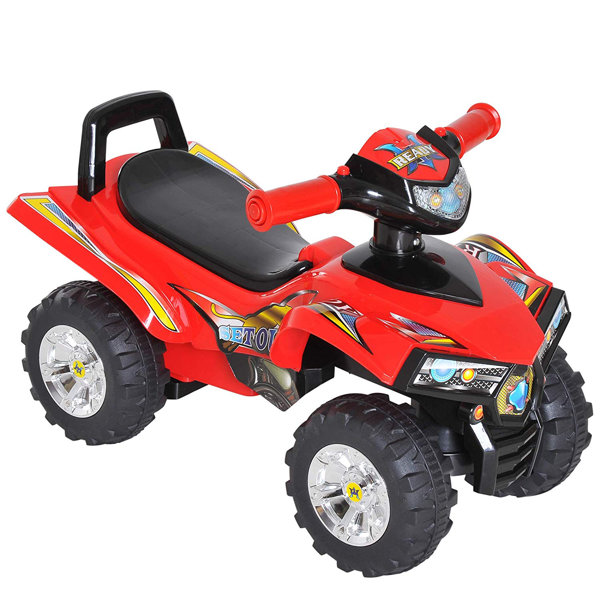Excellent News To Picking Kids Ride On Cars
Wiki Article
What Ride-On Car Features Should I Be Considering? Pros And Cons
The safety features of a child's ride-on car are crucial to their safety and enjoyment. Below are some safety features you need to consider.
Pros: Seat belts are the best option to ensure your child is safe in their ride-on car. They can reduce the risk of him slipping out of the play area or getting ejected. They provide an extra layer of safety especially when you make sudden turns or stopping suddenly.
Cons – Some ride-ons cars, especially those intended for children are not equipped with seat belts. Children might be able to find seat belts restrict their mobility or uncomfortable and may decide to avoid or refuse to use them.
Sturdy Construction
Pros: A robust ride-on car made of high-quality components will last for longer and be less likely to fail. This guarantees the safety and security of your children. It can stand up to all challenges of playing and offer stability.
Cons - Strong construction can be costly, which makes it unaffordable for some families. The more heavy materials used could limit the mobility and maneuverability.
The Low Center of Gravity -
Pros- Ride-ons with a reduced center of gravity will be less likely to tip, reducing the chance of accidents. They are more stable and have better balance. stability, particularly during turns or maneuvers.
Pros - Ride-on cars which have a low centre of gravity could compromise off-road capability or the clearance of their ground, which restricts their versatility.
Remote Control for Parents -
Pros: Remote controlled cars provide parents with the ability to monitor and supervise their child's playing, adding an extra layer of control and safety. Parents can intervene to avoid accidents, navigate through difficult terrain, and help their child in an emergency situation.
Cons - Parental remote control may limit children's independence and independence, since they depend on the guidance and support of their parents during play. Furthermore, models that can be controlled remotely may be more expensive than models with manual controls.
Speed Limiters
Pros: Ride-ons equipped with speed limiters as well as adjustable speed settings allow parents to decide on the maximum speed for their car. This helps reduce the possibility of a crash or collision. They can increase the maximum speed as their child's confidence improves.
Cons - Some children may get used to the slower speeds very quickly, leading to disappointment and frustration. Some models may not have speed limiters or require other options or features.
Safe Start Technology -
Pros- Safe start provides smooth and steady stops and starts of the car ride which reduces the danger of abrupt jerks or movements which could frighten a child or cause them to lose their balance. It provides a more relaxing and safer ride.
Cons - Some rides that have safe-start technology are more expensive than cars without it. A few children might also feel that the gradual acceleration or deceleration are less engaging and exciting than sudden starts and stops.
Visibility Enhancements
Pros - Ride-on cars with visibility enhancements such as working taillights, headlights, or reflective materials improve visibility, particularly in low-light conditions or in dimly lit areas. They are also more noticeable, which improves safety.
Cons - The increased visibility may cause the battery to drain more quickly, or increase the level of complexity. This could increase the risk of problems or maintenance.
When you consider these safety features and weighing their advantages and disadvantages, you can select an auto ride-on that will prioritize your child's safety while providing an enjoyable and fun play experience. View the top JCB ride on toys for blog info including kids electric cars, toy ride, toy a car, electric rideons, childs car toy, car toy toy, toy with car, a toy car, ride ons, riding digger and more. .

How Do You Maintain And Put Together A Child's Ride-On Car?
Making and maintaining toys for ride-ons for children is crucial to ensure their safety, functionality and longevity. Here are a few common assembly and maintenance needs for children's ride-on cars:
Most ride on cars are partially assembled upon arrival, and need some assembly. Connecting steering wheels, wheels, seats, and other components as in accordance with the specifications supplied by the manufacturer are typically required.
Install the components in accordance with the directions. Use the hardware and tools provided to complete the process.
Cleaning
For the ride on car to appear its most attractive and function effectively, regular cleaning is required. Use a dampened soft cloth with water and mild soap to clean the exterior surfaces.
Pay attention to areas prone for accumulation such as the tires or wheels, as well as the undercarriage. Use a brush or toothbrush to clean hard-to-reach places and get rid of stubborn dirt.
Beware of harsh chemicals and detergents that are abrasive. They can damage electronic components or paint of the ride-on car.
Battery Care
It is important to take care of the battery when your ride-on vehicle is powered by a battery which can be recharged. This will help you maintain the performance of your battery and extend its the lifespan of the battery. Here are some tips on battery care.
Fully charge the battery before use and each time to ensure maximum runtime.
Avoid overcharging batteries or leaving them hooked up to chargers for prolonged time. These actions can damage batteries and decrease their lifespan.
Store the ride-on car and battery in a dry, cool place when not in use in the sun's rays or extreme temperatures.
Periodically inspect the battery terminals for damage or corrosion, and clean them using a wire brush or terminal cleaner If necessary.
Replace the battery in case it does not hold an charge any longer or exhibits signs that it has been damaged or degraded.
Tire Maintenance -
Check the tires regularly for signs of damage, wear or loss of air. When needed, utilize a bicycle air compressor or an air compressor to fill the tires to the pressure recommended by.
Check the tread pattern and see if there are any foreign objects or particles which could lead to flats or punctures. Replace worn tires and clear any obstructions.
Lubricate wheel bearings and axles regularly to lessen friction.
Occasional repairs or replacements
Despite regular maintenance, certain ride-ons might require repairs or replacement parts from wear and tear.
Look out for any indications of a malfunction or degrade, such a strange noise or erratic behavior, or a loss of power. To find solutions to troubleshooting and repair, consult the manufacturer's instructions.
Replace damaged or worn-out components promptly to prevent any further damage, and ensure the safety and performance of the ride-on vehicle.
You can make sure your kid's rideon car is in top condition by following these assembly and care guidelines. Your child will enjoy numerous hours of safe enjoyable and thrilling playtime. See the recommended find out more on electric kids cars for more examples including cars pedal car, electric two seater cars, childrens electric ride on, childs car toy, two seater electric cars, ride on digger, ride on car, ride on digger, childrens ride on, toy car toy car and more. .

What Are The Possibilities For Remote-Controlled Cars For Children? What Are The Advantages And Disadvantages?
Remote-controlled cars for children, also known as RC cars, come in a range of designs, sizes and prices to meet different budgets and needs. The pros and cons, as well as the sizes styles, models, and prices of remote-controlled children's vehicles are listed below.
Electric RC Cars - Battery-powered remote-controlled cars that can be used for both outdoor and indoor use. They come in a variety of styles such as buggies, trucks or sports cars.
Nitro RC Cars – Gas-powered remote controlled cars with greater performance and speed However, more maintenance and expertise is required in order to operate. They're larger and generally cost more than electric RC Cars.
Scale Models (Remote-controlled replicas) - These are miniatures of real-life vehicles such as airplanes, trucks or automobiles. Scale Models are offered in a variety of scales which range from 1-10 all the way to 1-24. The larger scales offer more detail and a realistic appearance.
Sizes -
Remote control children's cars come in a range of sizes, from small miniature models to huge-scale replicas. The size can have an impact on the efficiency of a car, its speed, and its handling characteristics.
Micro-sized cars are small and lightweight. They are ideal for indoor use with younger children. These larger models have more power and are durable and are perfect for off-road and racing in the outdoors. driving.
Prices
Prices vary depending on the size, features brand and the build quality.
Electric and Nitro RC vehicles in larger scale can cost between $100 and $500.
Model cars of scale and high-end hobby RCs range from several hundred and over a 1,000 dollars, based on how detailed and powerful they are.
Pros & Cons
Pros -
Entertainment - Remote control children's cars provide hours of entertainment and excitement for both adults and children.
Skills Development - Operating an RC car can help children develop eye coordination, spatial awareness and problem-solving skills.
Social Interaction - RC vehicles can be enjoyed with family and friends, and encourage interactions and socialization.
Aftermarket parts including upgrades, accessories, and other products from the aftermarket can be used to modify many RC cars and improve their performance.
Cons
Cost - A top-quality model with advanced features can cost a lot, particularly for hobby grade models.
Learning Curve - Operating an RC car takes some practice and. Children who are younger may struggle to control the controls.
Maintenance is a must for RC car owners. They should regularly clean, lubricate, and make repairs or replace the parts.
Safety Concerns - RC vehicles can present security risks, such as collisions, falls, as well as electrical dangers, if utilized in a responsible manner and with adult supervision.
The best remote control children cars provide an educational and fun experience to children of all different ages. When selecting the best model for your child however, you must consider several factors, including the size, cost features, and security. The RCs that are designed for hobby use may be ideal for more advanced kids and those who love to drive while simpler models will suit youngsters and children who are just beginning to learn. Follow the top electric kids cars kidscars.co.uk recommendations for more advice including childrens digger, kids electric cars, ride of car, riding digger, kiddies cars, electric ride on, toy cars, toy car, ride ons, kidscars and more. .
